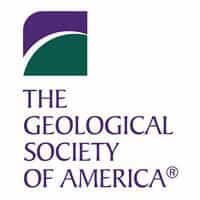
Denali Duck-Billed Dino Tracks
New GEOLOGY articles published online on 30 June 2014
Boulder, Colo., USA – A trio of paleontologists has discovered a remarkable new tracksite in Alaska’s Denali National Park filled with duck-billed dinosaur footprints -- technically referred to as hadrosaurs -- that demonstrates they not only lived in multi-generational herds but thrived in the ancient high-latitude, polar ecosystem. The paper provides new insight into the herd structure and paleobiology of northern polar dinosaurs in an arctic greenhouse world.
The article, "Herd structure in Late Cretaceous polar dinosaurs: A remarkable new dinosaur tracksite, Denali National Park, Alaska, USA," was written for Geology by lead author Anthony R. Fiorillo, curator of earth sciences at the Perot Museum of Nature and Science, and co-authors Stephen Hasiotis of the University of Kansas and Yoshitsugu Kobayashi of the Hokkaido University Museum.
"Denali is one of the best dinosaur footprint localities in the world. What we found that last day was incredible -- so many tracks, so big and well preserved," said Fiorillo. "Many had skin impressions, so we could see what the bottom of their feet looked like. There were many invertebrate traces -- imprints of bugs, worms, larvae and more -- which were important because they showed an ecosystem existed during the warm parts of the years."
**FEATURED ARTICLE**
Herd structure in Late Cretaceous polar dinosaurs: A remarkable new dinosaur
tracksite, Denali National Park, Alaska, USA
Anthony R. Fiorillo et al., Perot Museum of Nature and Science, 2201 North
Field Street, Dallas, Texas 75201, USA. Published online 30 June 2014;
http://dx.doi.org/10.1130/G35740.1
Other GEOLOGY articles (see below) cover such topics as
1. The beneficial effect of Saharan dust in the Bahamas;
2. Geochemical fingerprinting of 25 trans-Atlantic dust events from North
Africa to Barbados;
3. Study of shark teeth from Banks Island, NWT, Canada, shows that in
the Eocene Arctic Ocean, sharks were abundant even in lower-saline conditions; and
4. Sample analysis from the largest volcanic eruption of the 20th century:
the 1912 Novarupta eruption, Alaska.
GEOLOGY articles published online ahead of print can be accessed online at http://geology.gsapubs.org/content/early/recent. All abstracts are open-access at http://geology.gsapubs.org/; representatives of the media may obtain complimentary articles by contacting Kea Giles at the address above.
Please discuss articles of interest with the authors before publishing stories on their work, and please make reference to GEOLOGY in articles published. Contact Kea Giles for additional information or assistance.
Non-media requests for articles may be directed to GSA Sales and Service, gsaservice@geosociety.org.
